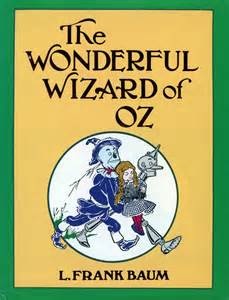 In 1900, L. Frank Baum published The Wonderful Wizard of Oz, a children’s book he wasn’t convinced would do particularly well – not compared to his fabulous Mother Goose and Father Goose collections a few years prior. Turns out it was a hit, and spawned multiple stage versions – usually musicals – and thirteen written sequels by Baum.
In 1900, L. Frank Baum published The Wonderful Wizard of Oz, a children’s book he wasn’t convinced would do particularly well – not compared to his fabulous Mother Goose and Father Goose collections a few years prior. Turns out it was a hit, and spawned multiple stage versions – usually musicals – and thirteen written sequels by Baum.
It was also turned into one very odd black and white silent film in 1925, directed by and starring a man with the very unfortunate name “Larry Semon.”
Egads.
The story was thus already pretty well-known when MGM released the vehicle by which most of us became acquainted with the Land of Oz – the 1939 Judy Garland film responsible for getting “follow FOLLOW follow FOLLOW…” stuck in our heads. After CBS decided to show it pretty much annually from 1956 until hell freezes over, in a time of three and only three major networks, it became a staple of Americana.
In the mid-1960’s, an educator by the name of Henry Littlefield published a piece arguing that The Wonderful Wizard of Oz was in fact an allegory of sorts – that in the spirit of Gulliver’s Travels or Animal Farm, Baum’s innocent tale was actually commentary on politics and economic policy in the late 19th century.
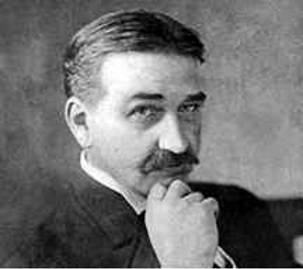
I’m no expert, but those who are find it highly unlikely Baum intended any such thing. Then again, I care very little what he INTENDED when he wrote it; I’m of the school that once an author releases his work into the world, it’s no longer his to control. If I want to use it as a ‘Parable of Populism’ – to make the history and fiscal disputes of the day a bit more palatable to teenagers – that’s damn well what I’m going to do.
Take that, dead writer guy.
It doesn’t take much Googling to find Littlefield’s essay or dozens of sites sharing their own variations. For those of you who aren’t quite THAT interested, but may nevertheless feel mildly curious enough to at least finish THIS post, the highlights go something like this:
The Scarecrow = Midwestern Farmers. While not considered particularly intellectual, they were smart in practical and stubborn ways. No matter how often they were knocked down or otherwise disassembled, they bounced back time and again. What they needed was to recognize this in themselves – they’d had it all along, you see.
“You see,” he continued confidentially, “I don’t mind my legs and arms and body being stuffed, because I cannot get hurt. If anyone treads on my toes or sticks a pin into me, it doesn’t matter, for I can’t feel it. But I do not want people to call me a fool, and if my head stays stuffed with straw instead of with brains, as yours is, how am I ever to know anything?”
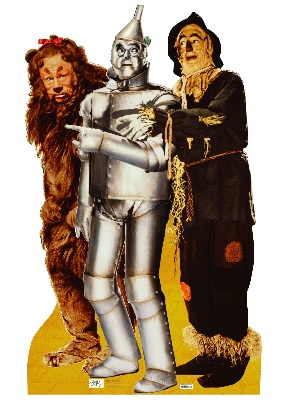 The Tin Man = Northeastern Factory Workers. Having slaved away under dehumanizing conditions for so long, they’d essentially lost their souls – their hearts – the parts which make us most human. Upton Sinclair would capture this less festively a few years later in The Jungle, a book he intended to be about the factory-driven destruction of the human spirit and instead ended up being about how gross sausage is. Meat-packing was reformed; factory labor continued to kill the human spirit for another few generations.
The Tin Man = Northeastern Factory Workers. Having slaved away under dehumanizing conditions for so long, they’d essentially lost their souls – their hearts – the parts which make us most human. Upton Sinclair would capture this less festively a few years later in The Jungle, a book he intended to be about the factory-driven destruction of the human spirit and instead ended up being about how gross sausage is. Meat-packing was reformed; factory labor continued to kill the human spirit for another few generations.
I thought I had beaten the Wicked Witch… [but] she thought of a new way to kill my love for the beautiful Munchkin maiden, and made my axe slip again, so that it cut right through my body, splitting me into two halves. Once more the tinsmith came to my help and made me a body of tin, fastening my tin arms and legs and head to it, by means of joints, so that I could move around as well as ever. But, alas! I had now no heart…
[[{“type”:”media”,”view_mode”:”media_small”,”fid”:”1352″,”attributes”:{“alt”:””,”class”:”media-image”,”typeof”:”foaf:Image”}}]]
The Lion = William Jennings Bryan. Before he went down in history as they guy who argued for Biblical values and against monkey-men in the infamous Scopes Trials, Bryan was THE voice of the Populist movement – and their candidate for President in both 1896 and 1900. His ‘roar’ had great impact on the farmers of the Midwest but far too little on the factory workers of the Northeast. He lost both times.
…[T]here came from the forest a terrible roar, and the next moment a great Lion bounded into the road. With one blow of his paw he sent the Scarecrow spinning over and over to the edge of the road, and then he struck at the Tin Woodman with his sharp claws. But, to the Lion’s surprise, he could make no impression on the tin, although the Woodman fell over in the road and lay still.
Dorothy = ??? Dorothy is our protagonist, our ‘everyman’. She need not represent anything or anyone other than us, the reader, responsible for our role in confronting the realities around us without the power to fully control any of them single-handedly. Some argue she’s an echo of Mary Elizabeth Lease, a rather vocal lecturer and writer who argued for women’s suffrage and temperance but was best known for her passionate orations in defense of populism. This may be hinted at in Judy Garland’s Dorothy, but the child in the original text isn’t the “raise less corn and more hell!” type by any stretch.
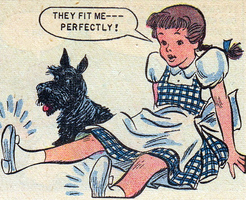 The Yellow Brick Road = The Gold Standard. It’s an almost sacred path to the Emerald City, but one fraught with inconsistency and danger. There are pitfalls and surprises, and even substantial gaps prohibiting all but the most creative travelers for going forward. But, when you add…
The Yellow Brick Road = The Gold Standard. It’s an almost sacred path to the Emerald City, but one fraught with inconsistency and danger. There are pitfalls and surprises, and even substantial gaps prohibiting all but the most creative travelers for going forward. But, when you add…
The Silver Slippers + The Yellow Brick Road = Bimetallic Standard. NOW we’re talking!
At that moment Dorothy saw lying on the table the silver shoes that had belonged to the Witch of the East. “I wonder if they will fit me,” she said to Toto. “They would be just the thing to take a long walk in, for they could not wear out.” She took off her old leather shoes and tried on the silver ones, which fitted her as well as if they had been made for her.
The folks at MGM were clearly unconcerned with allegorical monetary policy when they opted to give Dorothy ruby slippers to better demonstrate the glories of the relatively new ‘Technicolor’ of the day. You can’t trust Hollywood, children! If they’ll lie about shoe color, they’ll lie about ANYTHING!
The Wizard / The Emerald City = The President and Washington, D.C. The consummate politician, the man behind the curtain presents himself with a different face to whoever he’s speaking at the time. His power is based on illusion and on the willingness of the people around him to believe. Mandatory eyewear is locked on every citizen or visitor to maintain the illusion of green – wealth, growth, and envy – and while Oz lacks a real power source such as gas, it has plenty of hot air. Enough to power a balloon ride back to Omaha.
First they came to a great hall in which were many ladies and gentlemen of the court, all dressed in rich costumes. These people had nothing to do but talk to each other, but they always came to wait outside the Throne Room every morning, although they were never permitted to see Oz…
The Witches = Support from N/S, Opposition from E/W – particularly the moneyed interests of the Northeast and the Railroads and other large scale owners in the west. In the Presidential Elections of 1896 and 1900, most of Bryan’s support came – if you view the results with sufficient preconceptions – from the North and the South. McKinley won due to support from the West and the East. If you look at it the maps just… right…
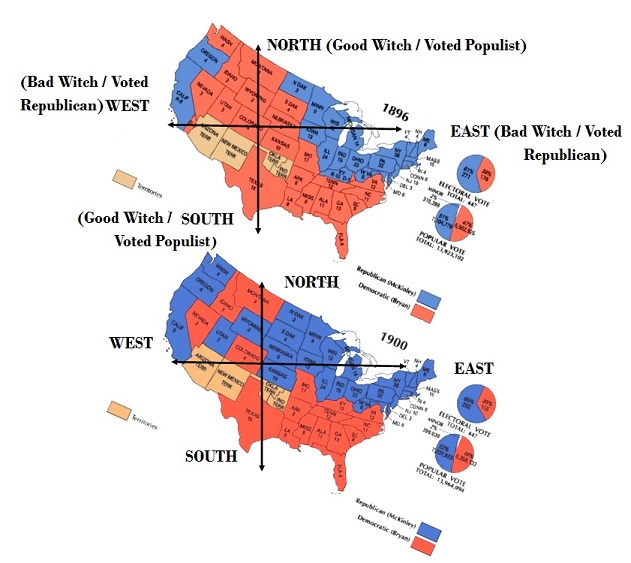
That’s the thing, though – once you’re looking for the allegory, it’s everywhere. Dorothy is constantly seeking and needing clean water, a primary obsession with any homesteader or farmer of the day. Water is what finally destroyed the Wicked Witch of the West, who primarily sends nature’s own dangers to thwart Dorothy and her friends. The Populist Party was born in Omaha, Nebraska – the birthplace of the Wizard once he’s no longer a political fraud and goes back to being a well-intentioned, if ineffective, travelling performer.
Soon the backstory of the flying monkeys seems to parallel the plight of American Indians and the field of poppies seems to have something to do with China and the people who break so easily are the postbellum South and –
It kinda takes on a life of its own.
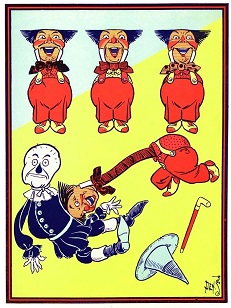 On the other hand, there are plenty of events which even the most creative mind can’t reasonably tie to history or populism. The Quadlings who lack arms but fire their heads at you on long necks are a fascinating obstacle, and the fragile ‘china people’ are far more poignant once you drop the weak ‘unreconstructed South’ connection. And how many varieties of ‘the little people’ (or field mice or Winkies or…) can one book have before it no longer makes sense to label them all with the same Jacksonian value?
On the other hand, there are plenty of events which even the most creative mind can’t reasonably tie to history or populism. The Quadlings who lack arms but fire their heads at you on long necks are a fascinating obstacle, and the fragile ‘china people’ are far more poignant once you drop the weak ‘unreconstructed South’ connection. And how many varieties of ‘the little people’ (or field mice or Winkies or…) can one book have before it no longer makes sense to label them all with the same Jacksonian value?
If it’s an allegory, it’s a rather inconsistent one.
It could, of course, be both – partly inspired by events of the day, partly rounded out as a colorful children’s tale. Just because the latest Captain America or Batman movies don’t strictly mirror current events doesn’t mean they don’t have plenty to say about our national ideals and choices in a time of perpetual ‘war on terror’.
But as I said, I don’t care. It’s a tool, and as long as it helps make bimetallism, third party politics, and the plight of the Midwestern farmer a bit more palatable for my darlings, I’ll just keep trotting it out – without shame. I could go looking for some better answer, some amazing new solution instead, but… seems to me in this case the thing I most need has been with me all along.
[[{“type”:”media”,”view_mode”:”media_small”,”fid”:”1353″,”attributes”:{“alt”:””,”class”:”media-image”,”typeof”:”foaf:Image”}}]]
RELATED POST: Let’s Have A (Populist) Party!
RELATED POST: Singing Bi, Bi, For Our Money Supply…

 Liberty is a tricky concept. On the surface it seems so simple – you are either free, or you are not. You have options and opportunity, or you do not.
Liberty is a tricky concept. On the surface it seems so simple – you are either free, or you are not. You have options and opportunity, or you do not. Only they can’t. Most can’t afford to live the way they wish to live or go all the places they wish to go. They may have to work just to eat. Social mores change around them as well, and while they may still technically behave any way they wish, they’ll begin to lose friends and employment, and their romantic options will be… unpromising. If they’re not particularly attractive or bright, the possibilities are even more limited. In a few years’ time, they’re back in mom and dad’s garage apartment, tolerating dinner conversation and being called ‘Brandon’ instead of ‘Sharktooth’ so they can eat something that doesn’t come in a box with a toy.
Only they can’t. Most can’t afford to live the way they wish to live or go all the places they wish to go. They may have to work just to eat. Social mores change around them as well, and while they may still technically behave any way they wish, they’ll begin to lose friends and employment, and their romantic options will be… unpromising. If they’re not particularly attractive or bright, the possibilities are even more limited. In a few years’ time, they’re back in mom and dad’s garage apartment, tolerating dinner conversation and being called ‘Brandon’ instead of ‘Sharktooth’ so they can eat something that doesn’t come in a box with a toy. The Wizard of Oz is full of examples. Dorothy and her cohorts encounter all sorts of opposition attempting to limit their ‘negative liberty.’ Angry trees, flying monkeys, and that green chick who sang ‘Defying Gravity’ all try to restrict or destroy them. When the primary source of this opposition – the Wicked Witch of the West – was removed, their negative liberty went way, way up!
The Wizard of Oz is full of examples. Dorothy and her cohorts encounter all sorts of opposition attempting to limit their ‘negative liberty.’ Angry trees, flying monkeys, and that green chick who sang ‘Defying Gravity’ all try to restrict or destroy them. When the primary source of this opposition – the Wicked Witch of the West – was removed, their negative liberty went way, way up! Freedman after the Civil War were suddenly given ‘negative liberty’. They could go wherever they wished, and do whatever they wanted. Most, though, ended up doing pretty much what they’d been doing before – working the soil for food and shelter. They lacked ‘positive liberty’. Why the fuss over
Freedman after the Civil War were suddenly given ‘negative liberty’. They could go wherever they wished, and do whatever they wanted. Most, though, ended up doing pretty much what they’d been doing before – working the soil for food and shelter. They lacked ‘positive liberty’. Why the fuss over  Sometimes the answer is that they don’t actually have the negative liberty we assume. A central theme of the #BlackLivesMatter movement is that police departments across the country forcibly prevent them from pursuing happiness, and sometimes take their lives as well. The Joads discovered serpents in the Promised Land of California – armed authorities limiting their movements, their speech, and their lifespans. Those are limits on ‘negative liberty’. Those are chains.
Sometimes the answer is that they don’t actually have the negative liberty we assume. A central theme of the #BlackLivesMatter movement is that police departments across the country forcibly prevent them from pursuing happiness, and sometimes take their lives as well. The Joads discovered serpents in the Promised Land of California – armed authorities limiting their movements, their speech, and their lifespans. Those are limits on ‘negative liberty’. Those are chains.
